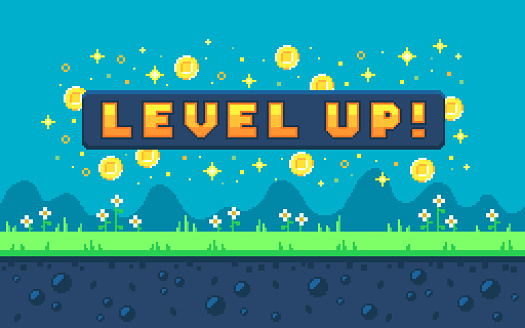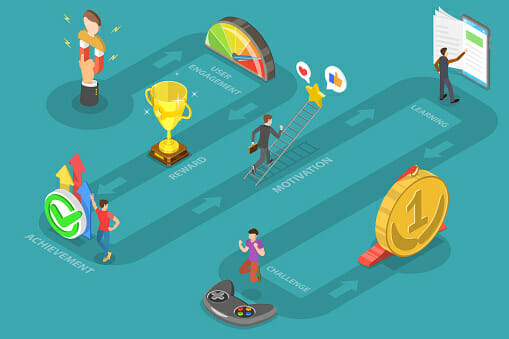
We live in a time when everything happens playfully and ordinary work no longer creates full enthusiasm. The principle of gaining experience through play has been well known for the generation that grew up with a home computer. Characterized by Datasetten, C64 and the legendary Amiga 500 or even better the Amiga 2000, this was the felt origin and the start of today’s gaming scene. The older games with the EGA or VGA graphic worlds had to be created with your own imagination, rather than just processing the almost realistic image that was rendered. Furthermore, a large number of game fans enjoy the retro games.
We were able to collect initial contacts with experience points, high scores, progress bars, rankings or awards at a young age. Driven to dominate the high scores in the circle of friends, generation after generation were aligned to a performance principle in order not to end up in the middle.
The focus on the performance principle within business life
A possible solution today to continue triggering this performance principle is simply called “Gamification”!
Training programs are used in a large number of companies, which increase the respective level on the basis of successfully completed training units. This approach especially motivates those who already felt joy at that time through successful leveling.
Everything is now a playful interaction and anchored in competition with each other and will never end and any kind of action brings XP (experience points) to climb the next rank. The narrow path between play and pressure to perform is fluid and must be well controlled by strong leadership in order to maintain balance and motivation among employees.
First a look at the quotes of the definition of the term “gamification” according to Wikipedia:
Gamification is the strategic attempt to enhance systems, services, organisations, and activities in order to create similar experiences to those experienced when playing games in order to motivate and engage users. This is generally accomplished through the application of game-design elements and game principles (dynamics and mechanics) in non-game contexts. It can also be defined as a set of activities and processes to solve problems by using or applying the characteristics of game elements. Gamification is part of persuasive system design, and it commonly employs game design elements to improve user engagement, organizational productivity, flow, learning, crowdsourcing, knowledge retention, employee recruitment and evaluation, ….. A collection of research on gamification shows that a majority of studies on gamification find it has positive effects on individuals. However, individual and contextual differences exist….
https://en.wikipedia.org/wiki/Gamification

Commercialization of the gaming scene and monetary incentives
Over generations the approaches of the gaming world have been commercialized drastically. In the present day , apparently the most important thing in the implementation of games is the business case and the highest possible profit from the product.
Contents such as fun and simplicity often fade into the background or were exchanged due to complexity and daily or weekly challenges. The emergence of entire digital worlds and currencies is taking on more and more traits, so that the young generation nowadays no longer realizes how much money is being invested in the digital world.
Another example is that governments now have to enact on regulations to drastically reduce the playing time of young people. This is a fact based on health developments and should raise concerns for all of us.
The premier class of the last few years is the unstoppable road to success of eSports competitions and communities in the gaming world. The sums that are now being paid in eSports can no longer be traced back to real comparisons for people who work “normally”. With games like DOTA or League of Legends, up to 34 million US dollars are set as prize money.
The professionalism of the participants suggests that a large number of hours were invested in winning these tournaments. The gaming scene is massively sponsored by companies in order to win the current “War of Talents”.
Where will we go in the next few years and what will we focus on?
Certainly you can motivate your employees to optimize their performance with a high proportion of gamification. The introduction of simple ranking lists or awards always creates a parallel world of those who drastically reject measuring points.
In countries like Germany, issues such as data privacy and unauthorized employee performance reviews are important challenges that companies do not have to neglect. In small start-up companies it is certainly easier and more effective and therefore of course more successful to implement, rational decisions and units of measurement in medium-sized and large companies are usually not subject to the principles of gamification.
The focus of today’s corporate growth is often on achieving the goals, which have been defined using figures, data and facts and which are difficult to reward with deviating “rewards” from the field of gamification. In addition, it is a question of generations whether there are already those in the company’s management who have had experience with the reward systems at a young age.
It’s an exciting time to see the extent to which large companies manage to keep their workforce consistently highly motivated. The options and solutions are numerous and only need to be combined in a meaningful way.
What would happen if the gamification component were drastically increased at the management level?
The dedicated hunt for experience points, high scores, progress bars, rankings or awards would certainly have a positive effect on the motivation of all those involved, but wouldn’t the hypothesis include that serious company management is being ousted?
The approaches of classic corporate management have been subjected to a change process by companies such as Google or Apple for a number of years, so companies nowadays have to deal with the trends much more aggressively than they did decades ago, when these tended to act parallel to business life. All channels must be used to generate positive attention in order to stay in business.
Is the gamification model able to push the classic KPI approach into a different perspective?
Fortunately, the models between gamification and the classic KPI approaches do not necessarily have to be viewed as opposing, it rewards those who confirm their performance based on personal or professional progress and deliver results or content accordingly.
Thus, both models have the goal of motivating and releasing feelings of happiness with different types of rewards, so we should in principle welcome both models in order to release a multitude of happiness in all employees.
It is important that the overall common good of the employees does not result in permanent and sustained competition with the gamification approach. The health developments in a permanent competitive mode are more noticeable in the last few decades than ever before.
Increasing numbers of so-called burn-outs and depression are already pushing “young” generations to the limit of their capabilities and health problems.
A few years ago, the proportion of daily screen working time was dramatically lower than in today’s home office era, which we will certainly see for a few more years in the hybrid model of the post-corona period.
How will we jointly shape the working models of the future?
A possible conclusion for the coming years could be an approximation of both models in order to implement the respective benefits in the best possible way.
The necessary conditioning and changes in working methods have led to the fact that, as in multiplayer games, we often only know our colleagues virtually, especially here managers in the post-corona period have to bring their teams together again in a focused manner in order to maintain the intense team spirit and not only to communicate via digital statistics, but rather to strengthen the need to also strengthen the point of socializing and togetherness.
There must be a consensus to continue to use the classic KPI model with the figures, data and facts. The advantages of gamification must define the motivation especially in the context of one’s own career path.
The humanitarian “Definition of Done”
As beautiful as the different models are that life is more than just a game and the important and beautiful moments should not only be documented by screenshot or streamed video, but lived in the moment 😉
Believe me, physical moments together are priceless, so take care of yourself and, for the sake of your health, be offline. After all, recovery is imperative to deliver top performance in business.

Sources:

 English | EN
English | EN 